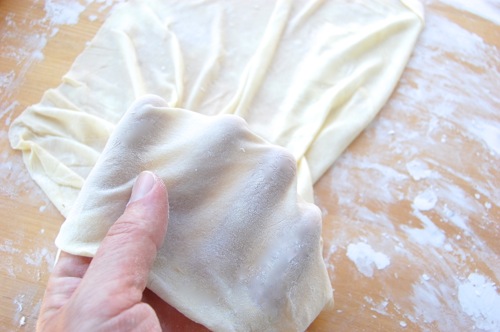A Little Filo Dough History

It’s funny how unusual questions tend to come in two’s and three’s. When that happens it makes me wonder if there’s a pastry class out there somewhere conducting an essay exam. Anyway, the question goes like this: when did the Greeks first start using filo dough?
It’s hard to say precisely. As far as I know the ancient Greeks didn’t have thin, filo-like doughs. Their hostile eastern neighbors the Persians, however, did. Ultra-thin doughs have a long history in the Middle East, dating back perhaps to the ancient Egyptians. The Persians invaded Greece in 492 B.C. and then again in 480 B.C., but didn’t stay more than a year in either case. No time for dessert-making classes, in other words.
The Greeks were taken over by the Macedonians a couple of hundred years later, then by the Romans. Greece remained a part of the Eastern Roman (later known as Byzantine) Empire for about the next 1400 years until the Ottoman Turks invaded the peninsula in about 1500. The Ottomans held the place until the Greek War of Independence in 1821.
Did the Ottomans like paper-thin pastry? Oh you betcha. And there we have our most likely answer: somewhere in that 300-year stretch of time. Close enough for jazz you guys?
When I was a kid we were active in the local International Institute and there were dozens of old world grandmas there. I remember watching the Greek grandmas pound dough incredibly thin, thinner than you could ever roll it. Then they would stretch it by hand over a floured table until it was so thin it covered the whole table and you could see through it. I doubt I would ever have the patience to do that.
Nothing like a little old lady to humble you, is there? I love that kinda stuff. Thanks, Frankly!
– Joe
The other thing I wish I could do that I saw was these little puff desserts. They would take a wad of dough & work it in their hand for a few seconds & then squeeze a bubble out between thumb & finger. These would be deep fried & coated in honey and sesame seeds. Light and crispy, sweet and lovely. They were trying to teach their kids/grandkids how to do it & I gave it a shot but all I ever got was a wad of dough.
Huh. I wonder what those are. Never heard of the technique but I’m keen to see it!
Cheers,
– Joe
I think it’s Loukoumades. I’ve seen a recipe where you squeeze the dough in your fist, and when it pokes out the top of your hand, you chop it off with a spoon (the dough, not your hand) into the hot oil.
Allison:
Yes, Loukoumades, but when I have had them since those heady days in the early 60s they are just lumps of dough, not the same thing at all.
Thin dough to encase fillings like honey, cheese and olive oil existed in Ancient Greece.
The name phyllo means leaf in Greek to imply how thin it should be.
Hello Marieke!
No question the Greeks have their own word for it. Please send me a reference for filo in Ancient Greece if you can find one since I’d be interested!
Cheers and thanks!
– Joe
Hi Joe. The Greeks don’t have their own word for it; it IS the same word (phyllo is filo which means leaf).
One reference can be found in Deipnosofists by Atheneaus and other ancient Greek literary works and plays.
Hi again Marieke!
We get our word for filo from Greek immigrants for sure. My point was only that other cultures have their own words for it (yufka, gollash, etc.). And I do know that reference you mean, for koptoplakous I think it is. Though if memory serves, Atheneaus describes that as being a three-layered dessert with a sweet nut filling. Somewhat similar to baklava, but with only one sheet of dough on top and another on the bottom to enclose the filling. I suppose it’s open to debate whether that constitutes a precursor to modern filo, however I’m still inclined to believe that the filo we know today comes by way of the Turks. Of course that’s just my opinion. I certainly appreciate your comments!
Cheers,
– Joe